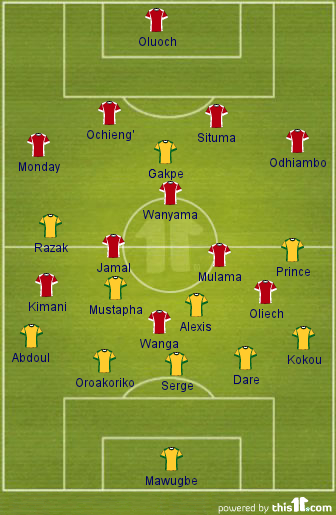A sigh of relief for Mathare United as they celebrated their first win of the season yesterday. A goal from Francis Ouma gave Mathare a win over fellow strugglers City Stars.
STARTING XI
Gabriel Njoroge deployed Titus Omondi and Lloyd Wahome in central defense, Dennis Nzomo and Ernest Wendo the central midfielders. With Andrew Tololwa roaming behind Francis Ouma.
Gideon Ochieng’ played Boniface Onyango and Dennis Okumu as the double pivot and with Francis Thairu still unavailable through injury, Dan Sserunkuma played alone in attack.
1. Mathare United in a 4-4-2
Njoroge has played a 4-2-3-1 entirely against AFC Leopards and Ulinzi Stars but he didn’t get a positive result out of those fixtures – it didn’t work.
Neither did Anthony Khadudu nor Andrew Tololwa push bodies high up to join in attack; they sat deep leaving the forward – Francis Ouma in most cases – alone in attack. Both Dennis Nzomo and Ernest Wendo stayed close to each other and deeper.
In this game, he started with a fluid 4-4-2 that quickly switched to a 4-2-3-1 when in defensive phase. He opted for a more direct approach with his team moving the ball forward and wide areas quickly.
In central midfield, the mobile Ernest Wendo partnered Dennis Nzomo and frequently drooped deep when defending to provide more protection to the defensive line before picking up balls and working them hastily to wide areas where Innocent Mutiso and Kelvin Omondi provided the width.
In a split attack, Andrew Tololwa roamed behind the main man Francis Ouma and had the freedom to drop deep when they lost the ball – a 4-2-3-1.
The 4-4-2 configuration worked well for them by approaching the match in a more direct way and getting the ball forward and to wide areas at a faster rate.
2. City Stars narrow
Gideon Ochieng’ played a narrow 4-2-3-1 formation. And an indication that City were going narrow is that Levy Muaka was benched. Dennis Okumu and Boniface Onyango the double pivot. Justus Basweti on the right flank and David King’atua drifting in from the left. Oscar Mbugua started as the attacking midfielder (though he left through an injury earlier on in the game, his replacement George Mwangi played in that position). Dan Sserunkuma was the lone forward.
This gave City a little superiority in the midfield zone but left them vulnerable down the flanks against a Mathare United side that worked the angles to get the ball down to wide areas. And again, they posed less threat to Mathare United from wide areas.
3. Mathare United switch to a 4-5-1
After Francis Ouma gave Mathare the lead, Gabriel Njoroge intent was to try and protect it. Vincent Okello who had replaced Andrew Tololwa earlier dropped deep and joined up with midfield. It seemed Okello would sit behind Ouma but in the end he was an extra midfielder. With City Stars having much time on the ball trying to get back and on rare occasions when Mathare United had the ball, Okello moved up in the hole.
The back line of Athman Buki, Lloyd Wahome, Tirus Omondi and Kenedy Ayong had more protection from Dennis Nzomo and Ernest Wendo who had dropped deep. Kevin Opiyo and Innocent Mutiso tracked City’s wide men and Francis Ouma was left alone in attack. Mathare United operated in a 4-5-1.
4. City Stars switch to a 4-4-2
After conceding the goal, Gideon Ochieng’ looked to strengthen his attack and try to get back into the game by approaching it directly and by having his side play quick balls forward.
He withdrew King’atua and in his place, he introduced Levy Muaka. Muaka went to the left flank, Justus Basweti to the right wing and George Mwangi moved up to join Dan Sserunkuma in attack. But Mathare United were well organized and time was against Ochieng’s men who were unable to unlock its opponents’ defense.
With City Stars a more threatening side with a 4-4-2 system, starting with a narrow 4-2-3-1 was a mistake by Gideon Ochieng’.
Follow me on twitter @BrainlessBull







